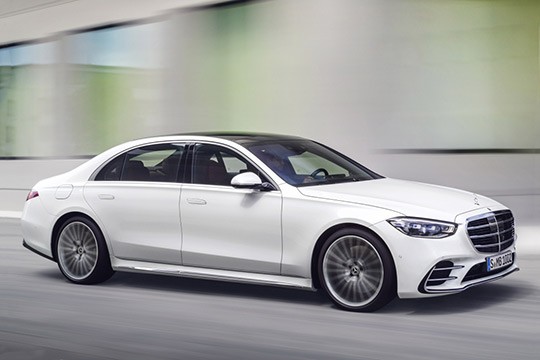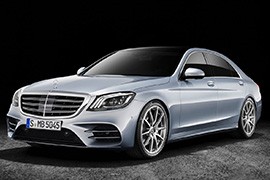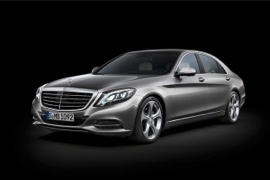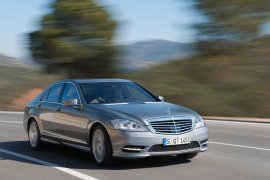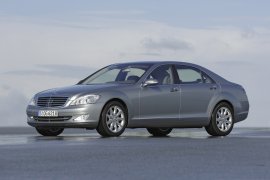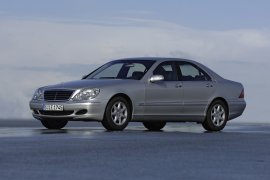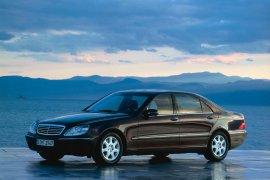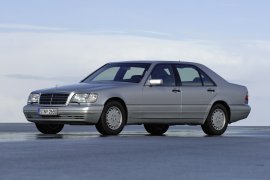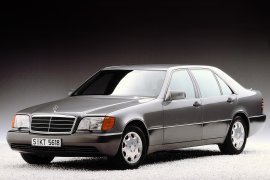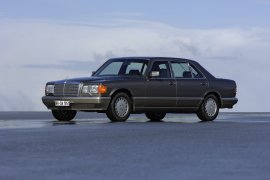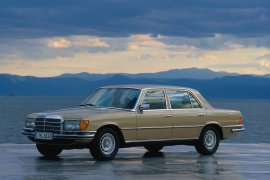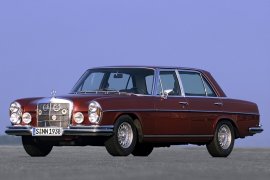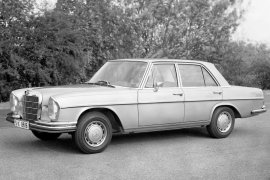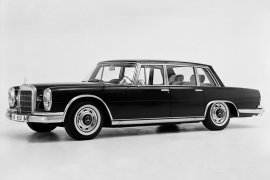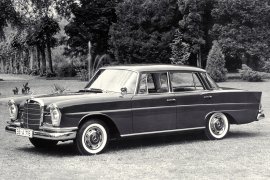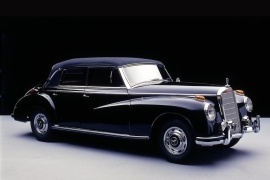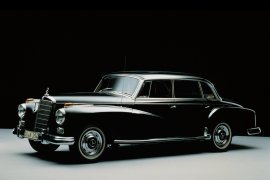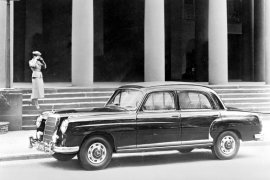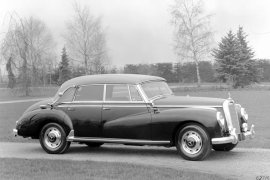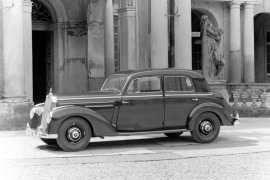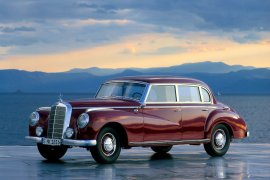MERCEDES BENZ S-Klasse and predecessors Models/Series Timeline, Specifications & Photos
First production year: 1951
Engines: Diesel, Hybrid gasoline, Hybrid, Gasoline
The S-Class was one of the premium vehicles that made the customers come again and ask for the new model. It was like an iPhone in the car industry.
Nine out of ten customers bought the S-Class in the long-wheelbase version. Around 80% of the Western European customers and 70% from the U.S. owners returned for the new version. That loyalty rate was a satisfaction proof hard to get by many other brands.
The 2020 model was not as much about the outside as it was for the comfort and safety features. Still, Mercedes-Benz couldn't let a facelifted model without exterior changes. The new headlights and the front bumpers were slightly improved over the non-facelifted version.
The interior was the one that gets more attention. The virtual reality came on-board in HUD, which virtually draws lines on the tarmac to follow the sat-nav directions. The MBUX (Mercedes-Benz User Experience) infotainment unit featured up to five screens with OLED technology. The voice commands didn't require the "Hey Mercedes" to activate it for all the functions. For instance, to answer the phone, the driver just had to say, "Answer."
A major improvement was the rear-axle steering, which reduced the turning circle by 6.2 feet (1.88 m) in diameter. The new 48v architecture allowed the car to be fitted with mild-hybrid technologies for most of the engines, including a V8 with an integrated starter-generator. The base version was powered by an inline-six turbocharged engine with direct fuel injection that provided 362 hp sent to the rear of the all-four wheels via a 9-speed automatic (dual-clutch) gearbox.
MERCEDES BENZ S-Class (W223) / (V223) S 350 d 4MATIC 9AT (286 HP)
MERCEDES BENZ S-Class (W223) / (V223) S 350 d 9AT (286 HP)
MERCEDES BENZ S-Class (W223) / (V223) S 350 d 9AT (286 HP) L
MERCEDES BENZ S-Class (W223) / (V223) S 400 d 4MATIC 9AT AWD (330 HP)
MERCEDES BENZ S-Class (W223) / (V223) S 400 d 4MATIC 9AT AWD (330 HP) L
The S-Class got a mid-life cycle refresh in 2017. Even if the exterior looked similar to the non-facelifted version, it still had more than 6000 parts in the car that were changed.
The Mercedes-Benz S-Class has been considered a benchmark for the luxury car segment for over 50 years. The car was constantly improved and most of the time it set the pace for the advanced safety and luxury features. The 2017 model was no exception for that, but on the outside, it shared only little details to tell that it was a facelifted model.
On the outside, the redesigned bumper, grille, and headlights were the main details that could tell a difference. The headlights featured three LED-lines for the daytime running lights. The C-Class had two lines and the E-Class two. The multi-beam LED headlights were fitted with an ultra range main beam that could lit the road ahead up to 650 meters (2132 ft).
The interior design featured a mix of leather, real wood, and hi-tech equipment, but combined to form harmonious interior design. The ample front seats are adjustable in any possible way a car-seat could have been adjusted. The interior of the new S-Class was characterized by the two new high-resolution displays, each with a screen diagonal of 12.3”. Visually, the two displays under one shared glass cover blended into a wide-screen cockpit, which contained a large display with virtual instruments in the direct field of vision of the driver as well as a central display above the center console.
For the suspension, the 2017 S-Class featured a new generation of Magic Body Control air-suspension, improved with a CURVE function that kept the car flat while cornering. A new range of engines with better fuel efficiency was introduced to the vehicle, including a plug-in hybrid since 2018.
Mercedes-Benz’s flagship model, the S-Class, entered into a new era when the German automaker unveiled the sixth generation of this nameplate in 2013 by boosting the technology package and improving the interior comfort and features.
Like its predecessors, the S-Class had to be fitted with the newest technologies Mercedes-Benz had in its basket. In addition, the vehicle was garnished with enough standard features to make a full-optioned former model turn yellow. Interestingly, the S-Class was the car that dethroned its more expensive sibling, the Maybach 57, which went belly-up in 2013. It just couldn’t match the level of comfort and the image of the S-Class, the best-selling car for governmental officials around the world.
For the 2013 model, also known as the W222, the S-Class came with a new look. The design team led by the Slovenian Robert Lesnik extensively used the organic lines envisioned on the 2007 Mercedes-Benz F700 concept car. As a result, the car sported swept-back headlights adorned with daytime running lights that looked like a line of pearls. The massive grille sported the traditional chromed horizontal slats. Behind them, the automaker installed the radar for the adaptive cruise control and other safety features. From its profile, the car lost the prominent wheel arches that made the W221 look sporty. The automaker tried, and succeeded, to create a luxurious-looking vehicle with a commanding look of the road, but without being aggressive. At the back, the corner-mounted taillights featured LED lights featuring three oblique elliptic shapes. Depending on the engine version, the dual exhausts were concealed under the bumper or exposed with chromed trims around them.
The S-Class was all about the comfort of the rear seats. For those, the automaker created a wide seat bench where three adults could sit comfortably. Even the middle-seated one could sit well, thanks to the low profile of the transmission tunnel that crossed the cabin from front to back. At the front, the seats featured mild bolstering since it was a vehicle fit for luxurious, comfortable rides, not sporty ones. Fronting the driver was a new, completely digital instrument panel extended over the center stack by the COMMAND infotainment unit display. The controller for that was housed on the center console, next to an armrest that concealed a storage compartment. Mercedes-Benz used man-made leather for the base models, including on the dashboard, while the upper trim levels were garnished with expensive, natural materials. Unusually for such a vehicle, the automaker installed a split panoramic roof, which opened above the front seats, but the glass area above the bench was fixed.
Mercedes-Benz created a new platform for the W222 and introduced one of the most comfortable air suspensions in the business. Its adaptive features allowed it to “read” the road ahead and prepare for the dampening of road irregularities. Under the hood, the German automaker installed a wide range of gasoline, diesel, and hybrid engines paired with seven-speed automatic transmissions that sent the power to the rear wheels. For selected markets and engines, the three-pointed star brand offered all-wheel-drive versions.
MERCEDES BENZ S-class (W222) S300 BlueTEC Hybrid Long 7AT RWD (231 HP)
MERCEDES BENZ S-class (W222) S300 BlueTEC HYBRID RWD (231 HP)
MERCEDES BENZ S-class (W222) S400 Hybrid 7AT RWD (306 HP)
MERCEDES BENZ S-class (W222) S400 Hybrid Long 7AT RWD (333 HP)
MERCEDES BENZ S-class (W222) S500 PLUG-IN HYBRID 7AT AWD (442 HP)
After four years on the market, the fifth generation of the S-Class received an update for the 2009 model-year and became even more attractive to its buyers.
Europe was still struggling with the financial crisis that hit the automakers, but Mercedes-Benz had its agenda, and, as usual for the Germans, it had to stick to it. Moreover, starting with 2009, Europe was switching to Euro 5 emission standards, so, besides the need for a visual update, the drivetrains had to be upgraded as well.
One of the most striking visual differences between the 2009 and the 2005 model years was in the lights department, where the facelifted version received LED DRLs. Moreover, the blinkers and the taillights received the same technology, depending on the engine version. In addition, the front bumper got a new styling with horizontal light strips placed on the lower outer scoops, where the 2005 S-Class featured fog lamps.
The interior was, like in any S-Class before, a luxurious place. Mercedes-Benz added new materials to the list and offered a unique experience with heated and vented seats, massage functions, individual infotainment units for the rear passengers, and a reclining bench for the long wheelbase version. In addition, the car was upgraded with a new pneumatic system that transformed every ride into a floating-over-the-road experience.
Under the hood, the most significant change was the introduction of the hybrid system that not only increased fuel efficiency but also lowered CO2 emissions. In addition, the entire range benefited from the newly developed 7G-Tronic gearbox that sent the power to the rear wheels or in all corners, depending on the version.
MERCEDES BENZ S-Klasse (W221) 250 CDI BlueEFFICIENCY 7AT RWD (204 HP)
MERCEDES BENZ S-Klasse (W221) 250 CDI BlueEFFICIENCY 7AT RWD (204 HP)
MERCEDES BENZ S-Klasse (W221) 350 V6 BlueTEC 4MATIC 7AT AWD (258 HP)
MERCEDES BENZ S-Klasse (W221) 350 V6 BlueTEC 4MATIC L 7AT AWD (258 HP)
MERCEDES BENZ S-Klasse (W221) 350 V6 BlueTEC 7AT RWD (258 HP)
MERCEDES BENZ S-Klasse (W221) 350 V6 BlueTEC L 7AT RWD (258 HP)
MERCEDES BENZ S-Klasse (W221) 350 V6 CDI 4MATIC 7AT AWD (235 HP)
MERCEDES BENZ S-Klasse (W221) 350 V6 CDI 4MATIC L 7AT AWD (235 HP)
MERCEDES BENZ S-Klasse (W221) 350 V6 CDI BlueEFFICIENCY 7AT RWD (235 HP)
MERCEDES BENZ S-Klasse (W221) 350 V6 CDI BlueEFFICIENCY L 7AT RWD (235 HP)
MERCEDES BENZ S-Klasse (W221) 350 V6 7AT RWD (272 HP)
MERCEDES BENZ S-Klasse (W221) 350 V6 BlueEFFICENCY 4MATIC 7AT AWD (306 HP)
MERCEDES BENZ S-Klasse (W221) 350 V6 BlueEFFICENCY 4MATIC L 7AT AWD (306 HP)
MERCEDES BENZ S-Klasse (W221) 350 V6 BlueEFFICENCY 7AT RWD (306 HP)
MERCEDES BENZ S-Klasse (W221) 350 V6 BlueEFFICENCY L 7AT RWD (306 HP)
MERCEDES BENZ S-Klasse (W221) 350 V6 L 7AT RWD (272 HP)
MERCEDES BENZ S-Klasse (W221) 450 V8 7AT RWD (340 HP)
MERCEDES BENZ S-Klasse (W221) 450 V8 L 7AT RWD (340 HP)
MERCEDES BENZ S-Klasse (W221) 500 V8 7AT (387 HP)
MERCEDES BENZ S-Klasse (W221) 500 V8 BlueEFFICIENCY 4MATIC 7AT AWD (435 HP)
MERCEDES BENZ S-Klasse (W221) 500 V8 BlueEFFICIENCY 4MATIC L 7AT AWD (435 HP)
MERCEDES BENZ S-Klasse (W221) 500 V8 BlueEFFICIENCY 7AT RWD (435 HP)
MERCEDES BENZ S-Klasse (W221) 500 V8 BlueEFFICIENCY L 7AT RWD (435 HP)
Whether it was needed for a CEO or a head of state, the 2005 Mercedes-Benz S-Class was ready in two wheelbases and with plenty of options.
The S-Class was the top vehicle from the German car-maker. It was the benchmark for comfortable cars all over the world. It was also on the front of the automotive technologies for safety and luxury, for more than five decades.
The new flagship model by Mercedes-Benz was larger than its predecessor in every respect. There was a choice of two body lengths - 5076 or 5206 mm (199.8" or 204.9"). The wheelbase has increased by 70/80 mm (2.75"/3.14") to 3035 and 3165 mm (118.4" and 124.6"), respectively. That meant plenty of legroom for the rear, most important, seats in the car. These new dimensions created the conditions for an interior concept, with first-class comfort.
The suspension featured the standard AIRMATIC air-suspension system that could be programmed for comfort or sport settings at the touch of a button.
Under the hood, there was a choice of V6 or V8 engines from the start, with the 3.5-liter as entry-level. Since in Europe there was a high demand for diesel units, a 3.0-liter was offered for the S320 CDI. Top of the range, the S600 V12 engine was available since 2006. For the transmission, the S-Class installed the 7G-Tronic as standard for the V6 and the V8 engines.
MERCEDES BENZ S-Klasse (W221) 350 V6 7AT RWD (272 HP)
MERCEDES BENZ S-Klasse (W221) 350 V6 Lang 7AT RWD (272 HP)
MERCEDES BENZ S-Klasse (W221) 450 V8 7AT RWD (340 HP)
MERCEDES BENZ S-Klasse (W221) 450 V8 Lang 7AT RWD (340 HP)
MERCEDES BENZ S-Klasse (W221) 500 Lang 7AT RWD (387 HP)
After the bulky S-Class W140, the appearance of the W220 took anyone by surprise. The S-Class was sleek, stylish, and looked more dynamic when it was introduced in 1999.
The 2003 S-Class model suffered subtle design changes. The front bumper's lower air intake was restyled, making the car look wider. The grille was taller. The headlights were covered with clear glass and the whole lamp featured a rounder look. The door mirrors and the taillights were refreshed as well.
Inside, there were over 40 elements redesigned in the 2003 S-Class. The multi-contour seats featured air-chambers that inflated and deflated according to the road conditions to offer better support for its occupants. For the infotainment system, the car was fitted as standard with the 6.5” COMAND unit. In the top of the range version S600, the unit was connected to the navigation system.
The most important safety innovation system was the PreSafe, which analyzed several sensors from the ESP and took actions by tensing the seatbelts, closing the windows, and the sunroof. If the accident was avoided, the PreSafe resumed to a standby mode. The 2003 S-Class was fitted with air-suspension and it was available with all-wheel-drive. Under the hood, the S-Class was fitted with a choice of six diesel or gasoline engines, ranged between 204 hp and 500 hp. All versions were mated with a 5-speed automatic gearbox.
MERCEDES BENZ S-Klasse (W220) 350 5AT (245 HP)
MERCEDES BENZ S-Klasse (W220) 350 Lang 5AT (245 HP)
MERCEDES BENZ S-Klasse (W220) 430 7AT (279 HP)
MERCEDES BENZ S-Klasse (W220) 430 Lang 7AT (279 HP)
MERCEDES BENZ S-Klasse (W220) 500 7AT (306 HP)
In 1998, Mercedes-Benz started producing the W220 S-Class and showed an entirely new image for its flagship model.
There were not too many people who regretted the previous W140 S-Class. While the former looked bulky and oversized, the 1998 model was just long. Another improvement was on the technical side, where the carmaker introduced an AMG-badged version with more ponies under the hood.
From the outside, the S-Class's aerodynamic shape was completely different from what its customers used to see in Mercedes-Benz's showrooms. The slanted grille and double-waved headlights created a dynamic image for the car. Its curved lines and body panels confirmed some reminiscences of the bio-design era, which was about to end.
Inside, the luxurious cabin spoiled its occupants with four seats. Despite its low greenhouse, the 1998 S-Class provided enough headroom even for taller passengers. In the long-wheelbase version, the carmaker added an option for footrests for the rear passengers. The carmaker added more features for the driver, including automatic climate control and power everything (windows, mirrors, seat, and sunroof). On the center stack, the carmaker added an infotainment unit that provided a DVD-based navigation system.
Under the sleek-looking bodywork, Mercedes-Benz installed a wide choice of engines ranged between a fleet-special 3.2-liter, inline-six turbo diesel, and a fast 5.8-liter V-12. The carmaker installed a standard five-speed automatic transmission for the entire range.
MERCEDES BENZ S-Klasse (W220) 320 5AT (224 HP)
MERCEDES BENZ S-Klasse (W220) 320 Lang 5AT (224 HP)
MERCEDES BENZ S-Klasse (W220) 430 5AT (279 HP)
MERCEDES BENZ S-Klasse (W220) 430 Lang 5AT )279 HP)
MERCEDES BENZ S-Klasse (W220) 500 5AT (306 HP)
The German automaker introduced a subtle facelift for its flagship model, the W140, trying to conceal the car's dimensions and proportions.
Mercedes-Benz introduced the W140 lineup in 1991, and soon it discovered that its flagship model was not as much appreciated as its predecessor, the beautiful W126 lineup. While the car was technologically advanced, its design was not on par with its main competitors and not even with its predecessor or with the smaller E Class from the same era. Things had to be changed quickly.
Usually, the German automaker didn't change design cues quickly, but this time it had to. As a result, it didn't wait for four years to apply them and introduced the facelifted version of the S-Class at the 1994 Geneva Motor Show in March. Thus, the amber turn signals and other elements that were easy to replace were upgraded. In addition, the front bumper and the side sills sported horizontal stripes that visually reduced the car's height.
Inside, the car remained as luxurious as ever, with leather upholstery and wood trims on the dash and door cards. Moreover, since it was the carmaker's flagship model, it was offered exclusively with a five-speed automatic gearbox (5G-Tronic). To help drivers park the car, starting with 1995, the S-Class could've been ordered with an ultrasonic parking system with sensors mounted into the front and rear bumpers instead of two retractable antennas on the rear quarter fenders.
Under the hood, the car offered a wide engine range, from inline-six to V12 powerplants for the gasoline versions. In addition, Europeans also received a choice of two turbo-diesel units.
MERCEDES BENZ S-Klasse (W140) 280 5MT RWD (193 HP)
MERCEDES BENZ S-Klasse (W140) 320 5MT RWD (231 HP)
MERCEDES BENZ S-Klasse (W140) 320 Lang 4AT RWD (231 HP)
MERCEDES BENZ S-Klasse (W140) 420 V8 5AT RWD (279 HP)
MERCEDES BENZ S-Klasse (W140) 420 V8 Lang 5AT RWD (279 HP)
MERCEDES BENZ S-Klasse (W140) 500 V8 5AT RWD (320 HP)
MERCEDES BENZ S-Klasse (W140) 500 V8 Lang 5AT RWD (320 HP)
The introduction of the 1991 S Class was one of the most significant turning points in the carmaker's history. It was the moment when it decided to return the V12-powered models and, moreover, to bring surprising technologies to the market.
The shocking look of the W140 S Class made a lot of people look angry, especially since its predecessor was prized for its elegance and beauty. But while the German carmaker didn't focus too much on the exterior, it took great care about other details that made this vehicle one of the best on the market at the beginning of the '90s.
Mercedes-Benz designed the W140 to look like a fortress. It was tall, wide, and long. Moreover, it was available in two wheelbases (SE and SEL). Customers could have even ordered a Pullman version, which was even longer. The front fascia was tilted backward and features large rectangular headlights with corner-mounted turn signals. The tall greenhouse continued the hood's ascending line, which ended in a sloped windscreen at the back. The carmaker installed two retractable antennas at the edges of its quarter panels for the parking sensors. It was a unique yet helpful option that later on became common on many cars.
The interior was lavish and excelled with high-quality leather upholstery complemented by wood veneers on the door cards, dashboard, and center console. Even with the standard wheelbase, the S Class offered plenty of legroom for the rear-seat passengers. The SEL, on the other hand, showed more luxurious options, including but not limited to a minibar, a footrest, and other amenities.
Under the hood, the base models featured an inline-six engine, either gasoline-powered or turbodiesel. The range-topper, on the other hand, featured a 6.0-liter powerplant that fed the horsepower battle with over 400 ponies on tap.
MERCEDES BENZ S-Klasse (W140) 300 SE 5MT RWD (231 HP)
MERCEDES BENZ S-Klasse (W140) 300 SE 5MT RWD (93 HP)
MERCEDES BENZ S-Klasse (W140) 300 SEL 5MT RWD (231 HP)
MERCEDES BENZ S-Klasse (W140) 400 V8 SE 4AT RWD (286 HP)
MERCEDES BENZ S-Klasse (W140) 400 V8 SEL 4AT RWD (286 HP)
MERCEDES BENZ S-Klasse (W140) 500 V8 SE 4AT RWD (326 HP)
MERCEDES BENZ S-Klasse (W140) 500 V8 SEL 4AT RWD (326 HP)
The second generation of the S-Class was launched at the 1979 Frankfurt Motor Show. It was offered with two wheelbases and four engine choices.
The S-Class W126 was a trendsetter of its times. It was the first Mercedes-Benz that featured plastic bumpers integrated into the front and rear apron areas, in a gray color that matched all the other colors for the bodywork. To amplify that new trend, on the sides there were plastic covers on the lower part of the doors and fenders that matched the color and pattern of the bumpers.
On the front, the design concept of its predecessor was enhanced. It kept the shape of the headlights but the turn-signals were different. The rear-view mirrors were no longer chromed but in body color. The long-wheelbase version was longer by 140 mm (5.5”) and it offered more legroom and wider rear doors. The car could have been fitted with driver airbag and ABS.
The interior was even more advanced for those times. The electrically adjustable front seats had the buttons mounted on the door panel, next to the armrest. The driver's seat also featured two memory positions. The automatic climate control was not a novelty for the automotive market and the S-Class had it.
The W126 was launched with four engine choices and later on, there were more options added. A 3.0-liter turbodiesel version was offered for the U.S. market. The W126 was engineered to be more fuel-efficient and it was also fitted with catalytic converters, to decrease the emission values. It was offered with a 5-speed manual or 4-speed automatic transmission.
MERCEDES BENZ S-Klasse (W126) 260 SE 5MT RWD (170 HP)
MERCEDES BENZ S-Klasse (W126) 280 S 4MT RWD (156 HP)
MERCEDES BENZ S-Klasse (W126) 280 SE 4MT RWD (185 HP)
MERCEDES BENZ S-Klasse (W126) 280 SEL 4MT RWD (185 HP)
MERCEDES BENZ S-Klasse (W126) 300 SE 5MT RWD (179 HP)
MERCEDES BENZ S-Klasse (W126) 300 SEL 5MT RWD (179 HP)
MERCEDES BENZ S-Klasse (W126) 380 SE 4AT RWD (204 HP)
MERCEDES BENZ S-Klasse (W126) 380 SEL 4AT RWD (204 HP)
MERCEDES BENZ S-Klasse (W126) 420 SE 4AT RWD (224 HP)
MERCEDES BENZ S-Klasse (W126) 420 SEL 4AT RWD (224 HP)
MERCEDES BENZ S-Klasse (W126) 500 SE 4AT RWD (231 HP)
MERCEDES BENZ S-Klasse (W126) 500 SE 4AT RWD (265 HP)
MERCEDES BENZ S-Klasse (W126) 500 SEL 4AT RWD (231 HP)
MERCEDES BENZ S-Klasse (W126) 500 SEL 4AT RWD (265 HP)
In 1972, the German car-maker launched the W116 series which replaced the previous W108/109 models. It was launched with 6 and 8 cylinders engines.
The Watergate scandal started, a gallon of gasoline was 55 cents and the average income per year in the U.S. was USD 11.800 and Bobby Fischer became World Chess Champion. In September that year, the first vehicle to receive the name "Mercedes-Benz S-Class" was launched and become a champion in its class. The horizontal headlights were brought in that class after the 1971 SL model.
The designer was Friedrich Geiger, the man responsible for the design of famous models such as the Mercedes-Benz 500K and 300 SL "Gullwing". For the new S-Class, there were developed cowl panels at the A-pillars, serving as water-shield gutters. Further safety details were wide wraparound direction indicators, well visible also from the side. In addition, broad rear lamps with ribbed surface profile proved to be very insusceptible to dirt.
Inside, there was plenty of room for five passengers, and, for the long-wheelbase, there was even more for the rear passengers. The dashboard featured three round dials. In the middle, there was the speedometer and on the left, there were three gauges for fuel level, coolant temperature, and oil pressure. The right dial was an analog clock. On the center console there were the sliders for the climate control unit and, if installed, a radio-telephone.
The W116 featured independent suspension on both axles and it had important new safety features such as antilock system (ALS) developed with Bosch. For the engine, the top model was the 6.9-liter V8 unit with a mechanical injection that offered 286 hp and 549 Nm (405 lb-ft) of torque.
It was a car that it wasn't planned and it was the result of a particular Mercedes-Benz engineer, Erich Waxenberger. He just took the biggest V8 from the shed and slammed it under the hood of a regular 300 SEL.
When the Mercedes-Benz chief engineer tested the car, it is said that at a stoplight he jumped out of the car and looked under the hood to see how the big V8 was installed. That gave him confidence and propose the series model. The production model was shown at the Geneva Motor Show in 1968 and it was a sensation. Even if the price tag was high for that era (DM 10.000 – USD 5.000), the customers came to ask for more and more. It was twice as much as a 300 SEL 280. According to Mercedes-Benz's official data, 6526 units were produced before the end of the series in 1972.
The exterior look was very close to the standard 300 SEL with a smaller engine. There were a few clues that the car was something different. The 6.3 could only be recognized by its wider tires, double halogen headlights, and additional high-beam headlights.
At the time of launch, it was the fastest four-door car in the world and it kept that title for many years. For the suspension, it featured a self-leveling system for the rear axle to keep the same level regardless of the load, four disc brakes, power windows and locks, and power steering.
With the “Fintail” model fading away after a successful career, Mercedes-Benz had to replace it with something better. And they did it with the 1965 luxury model.
The 1965 S-Class was offered with two wheelbases, the shorter ones being more driver-oriented than for the rear-passengers. The new generation kept the nameplates as 250 S, 250 SE and 300 SE, which succeeded the “fintail” types 220 Sb, 220 SEb and 300 SE. .
It was designed by the famed French designer Paul Bracq. He adopted simple lines for the bodywork and chromed details to emphasize the luxury vehicle. It had vertical headlights, a concept that was different from other car-manufacturers at that time when most of the other car-manufacturers offered round or horizontal units. The 300 SE ditched the air-suspension from the previous model, but it had a hydropneumatic system to compensate the rear axle that could maintain a constant level to the car, regardless of the weight added to the car.
In 1966, the 300 SEL, the longer version of the 300 SE. Its 100 mm (4”) longer wheelbase was used for increased legroom for the rear passengers. Compared to its siblings, this version featured an air-suspension. While the other versions had the W108 designation code, the 300 SEL was named W109, which corresponded to an approximate 109” (2850 mm) wheelbase, compared to the 108” (2750 mm) wheelbase of the W108 models. Initially, the numbers were related to the engine size but latter on, Mercedes-Benz added specific figures for that, such as it was the 300 SEL 6.3 or 4.5, which represented the 6.3-liter and 4.5-liter units, respectively.
MERCEDES BENZ S-Klasse (W108/W109) 250 S 4MT RWD (129 HP)
MERCEDES BENZ S-Klasse (W108/W109) 250 SE 4MT RWD (150 HP)
MERCEDES BENZ S-Klasse (W108/W109) 280 S 5MT RWD (140 HP)
MERCEDES BENZ S-Klasse (W108/W109) 280 SE 3AT RWD (199 HP)
MERCEDES BENZ S-Klasse (W108/W109) 280 SE 4MT RWD (200 HP)
MERCEDES BENZ S-Klasse (W108/W109) 280 SE 5MT RWD (160 HP)
MERCEDES BENZ S-Klasse (W108/W109) 280 SEL 3AT RWD (199 HP)
MERCEDES BENZ S-Klasse (W108/W109) 280 SEL 4MT RWD (200 HP)
MERCEDES BENZ S-Klasse (W108/W109) 280 SEL 5MT RWD (160 HP)
MERCEDES BENZ S-Klasse (W108/W109) 300 SEb 4MT RWD (170 HP)
MERCEDES BENZ S-Klasse (W108/W109) 300 SEL 3AT RWD (199 H)
It was the car built for the richest people in the world. At the time of its launch, it was the most expensive car in the world and the technology involved was way ahead of its time. That was the Mercedes-Benz S600 W100.
The "Grand Mercedes" as it was known, was created as a representation vehicle for the top leaders of the world. Some of the world-known figures such as John Lennon, Elvis Presley, Elizabeth Taylor or Hugh Hefner and many others owned such a vehicle. It was available in wheelbases up to 3.9 m (153.5") long. Inside there was room for four or six people with a rear bench seat.
The luxurious limousine was available with a fixed roof or a landaulet version where the rear side of the roof was a canvas top that could be folded down. It was intended to be also used as a presidential vehicle and the nation's leaders could stand up and wave to the crowd. Some dictators such as Nicolae Ceausescu, Leonid Brezhnev, Todor Zhivkov and others used it for military parades.
For the comfort of their owners, the S600 featured a complicated hydraulic system that controlled the suspension, the power seats, power windows, power trunk-lid and, of course, the power-steering.
Since the car had almost 3 metric tons, the car was fitted with heavy-duty brakes with discs in all four corners. The front discs had two brake-calipers per wheel. But even after 40 years, the S600 was one of the most comfortable cars in the world. Its massive 6.3-liter engine featured a mechanical multi-point injection and offered 300 hp. But 50 hp were needed for the hydraulic system.
In August 1959, Mercedes-Benz introduced its new top-luxury model: the 220 model. A car built in the American style of “fintail”, but with German engineering.
The transition to the “ponton” style bodyworks, with flushed fenders and doors, was continued to the new generation of the upper-class vehicles from Mercedes-Benz. The new range was introduced with six-cylinder engines and with a specific motto: “A class of its own”. They were built on two different chassis: the W111 from 1959 and on the W112 from 1961.
From the outside, the grille was narrower than the front fascia. It covered only the radiator's area. The tall and narrow headlights were placed on the front side of the fenders. Depending on the engine, the car featured more or less chromed elements. In the back, the taillights were installed horizontally, despite the tall rear sides of the quarter panels in a slim tail fin that gave the car the nickname “fintail”. The vehicles built on the W112 chassis featured a chromed element on the C-pillar.
Inside, the car offered up to five seats on comfortable seats for the front and a wide bench in the back. The leather upholstery was not standard and most of the cars were fitted with cloth seats. The column-mounted gear-shift lever. The instrument cluster was narrow and tall.
The W111 and the W112 models, were powered by 6-cylinders engines only with power ranged between 95 hp and 160 hp. The 3.0-liter engine was carried over from the 300 d model. In those times, “d” didn't mean diesel. For the transmission, the car was available with a 4-speed manual and, from 1961, with a 4-speed automatic produced by Mercedes-Benz.
MERCEDES BENZ S-Klasse "Grosse Heckflosse" (W111/W112) 220 b 4MT RWD (95 HP)
MERCEDES BENZ S-Klasse "Grosse Heckflosse" (W111/W112) 220 Sb 4MT RWD (110 HP)
MERCEDES BENZ S-Klasse "Grosse Heckflosse" (W111/W112) 220 SEb 4MT RWD (120 HP)
MERCEDES BENZ S-Klasse "Grosse Heckflosse" (W111/W112) 230 S 4MT RWD (120 HP)
MERCEDES BENZ S-Klasse "Grosse Heckflosse" (W111/W112) 300 SE 4MT RWD (160 HP)
MERCEDES BENZ S-Klasse "Grosse Heckflosse" (W111/W112) 300 SE Lang 4AT RWD (160 HP)
In 1951, at the first Frankfurt International Motor Show after the WWII, Mercedes-Benz unveiled among other new vehicles the top-of-the-line 300 series. It was the biggest and fastest German car in production.
The 1951 model was the 300 it evolved in a series of models with several modifications. While the 1951 model was not named 300 a, the 1954 version received the 300 b name and the 1955 model was the 300 c. All of them had an open-top version named Cabriolet D. In 1957, a profoundly revised version of the 300 model was presented, which, technically as well as regarding its exterior, was clearly different from its predecessor. The design number W 189 confirmed a new construction with its own series for the model 300 d.
The body of the 300 d was updated, especially regarding the roof and the C-pillars. As well as the limousine, which, like its predecessor, could be fitted with a sliding roof or a partition wall, a Convertible D was also available from December 1958. It was much more expensive than the closed version, which led to a very limited number of units produced.
Despite being a convertible, the 300 d Cabriolet D featured an Artic-Kat air-conditioning unit on the options list. Inside, the car-maker installed new seats, with better support for the back of its occupants.
A big improvement was found under the hood, where an inline-six unit was fitted with a Bosch gasoline injection system in the manifold, instead of a classic system with a carburetor. It was fitted as standard with a 3-speed automatic transmission. A manual gearbox was on the options list. The four-door cabriolet version was produced in only 65 units.
In 1957 Mercedes-Benz heavily upgraded Typ 300 limousine, and built its new flagship model on top of a platform known as W189.
Mercedes-Benz's flagship model had to be changed after six years on the market. Even though it sported a similar shape, the new vehicle was built on top of a new platform with a long wheelbase and additional amenities. Still, the drivetrain was carried over from the W186, but it kept the same "Adenauer" nickname, honoring the chancellor who put Germany back on the map after WWII.
With its flared wheel arches visually extended over the front doors, the Typ 300 D was a luxurious vehicle. At the front, the car kept a similar front fascia as the W186, with a tilted radiator grille and new round headlights. In addition, the automaker installed parking lights on the front fenders, located between the chromed bumper and the headlights' trims. From its profile, the 1957 model featured a faux-cabriolet shape with a retractable B-post. At the back, the car sported small taillights on the large quarter panels.
Inside, Mercedes-Benz created a luxurious cabin with wood trims on the dashboard and door cards. At the front, there was a benchseat for two, while in the back, the bench was fit for three, even though it was profiled for just two persons.
The three-pointed star brand made a significant upgrade for the inline-six powerplant installed in the car, with the addition of a Bosch fuel-injection system. Thanks to this, it managed to squeeze 160 European ponies (158 hp) from the three-liter engine. Power went to the rear axle via a three-speed automatic or a four-speed manual.
The 1954 luxury car from Mercedes-Benz was introduced: the 220, or W180 as it was known in the internal coding system. It was based on a new design concept, in a close relationship with the 180 model.
The design language was drastically changed less than a decade after WWII. The era of flared wheel-arches, tall and narrow engine compartments, and vertically ended cabins was over. The Typ 180 brought a new style, named Ponton, with wider engine compartments and flush fenders and door panels. The trunk started to look different, with a horizontal lid.
The 220 followed the same design cues but in a different size. There was an increase in the wheelbase by 170 mm (6.7”) resulting in 70 mm (2.75”) more legroom for the rear passengers and an extra 100 mm (3.93”) for the engine compartment, needed to accommodate the six-cylinder engine. The hood surrounded the radiator grille almost to the bumper.
The interior was comfortable for up to five passengers. The gear-shift lever was installed onto the steering column and the dashboard featured an elegant look, with a square analog clock in the middle. The instrument panel featured a round speedometer in the center and two pairs of gauges placed symmetrically to the left and right of it. To add more comfort for the driver, there was an option for a hydraulically activated clutch.
The engine compartment was designed for inline-six engines. It all started with a 2.2-liter unit that offered 85 hp, while the top version featured a 115 hp unit from the same displacement, but with the help of a mechanical fuel injection system. All versions featured 4-speed manual gearboxes.
Mercedes-Benz stirred the world of premium carmakers when it introduced the 300d at the 1951 Frankfurt Motor Show, and that wasn't all; it offered it in an open-top version as well.
After just six years since the end of WWII, the German carmaker was back on its feet. It understood that it had to continue its mission with luxury vehicles that brought it fame before the war. It gathered all the specialists it had and created a unique car that became a must-have luxury vehicle. It wasn't Rolls-Royce, but it was pretty close in terms of advanced engineering and comfort.
The era of wide fenders and narrower and taller engine compartments was closing to an end, but the carmaker was not yet ready to take that step. But it enhanced the concept by including the headlights in the front fenders and tilted the radiator's grille. Its curved fender lines were extended over the front door, while the rear doors sported a curved lower side that emerged into the rear quarter panels. At the back, the curved, sloped-down trunk made the car looks more dynamic. For the canvas-top, the carmaker used the same solutions from the pre-war convertibles, including the exposed metallic parts for the retracting mechanism.
Inside, Mercedes-Benz used two individual seats for the front occupants and a wide bench for the rear ones. It was a car built for comfort, and that was reflected into the rear legroom, where the passengers couldn't complain. Although, they had to work their muscles to help cover or uncover the vehicle.
Under the hood, the carmaker installed a 3.0-liter inline-six engine paired as standard to a four-speed manual gearbox. Thanks to its independent suspension in all corners, the vehicle provided a higher comfort level than most of its competitors, who were still relying on a rigid rear axle.
In 1951, Mercedes-Benz unveiled the new 220 model. It replaced the former 170, paving the way to the S-Class. It was the first step
Only six years have passed after the end of WWII and the German automotive industry started to rise back from its ashes and opened the gates of their first Motor Show in Frankfurt. The new model was trying hard to separate from the pre-war models. It was also the first post-war Mercedes-Benz with an inline-six engine.
The 1951 Mercedes-Benz 220 featured flared arches over the front wheels, with a raised engine bay as in the pre-war vehicles. The main difference was that the headlights were enclosed in the fenders and not supported by bars, as before. The flat windshield and raised greenhouse still resembled some pre-war vehicles, such as the W153. The sedan version, featured suicidal-type front doors, with the rear doors being hinged on their front side. The spare-wheel was placed inside the trunk.
Inside the car, there was room for four passengers, with more legroom for the rear occupants. Since Mercedes-Benz was a luxury brand before the war, it tried to stay on the same path even though the times were different.
Part of the technological archive and the engineers survived the war and gathered back to rebuild the brand. They installed a new inline-six engine with an overhead camshaft, which was unusual. And it worked well. The 80 hp unit was better than what the manufacturer obtained with the former 2.2-liter unit from 1938 that offered 55 hp.
Mercedes-Benz introduced the elegant Model 300 in 1951 and quickly gained its status as a luxury vehicle, and soon became the vehicle of choice for the newly formed West Germany.
The German automaker didn't suffer the same consequences as other carmakers from Germany after WWII. Thus, it could work double-time to develop new vehicles. Thus, in 1951, it unveiled a completely new model, designed from the ground up, based on the carmaker's X-frame chassis. The car's nickname, Adenauer, came from Germany's first chancellor after the war, Konrad Adenauer, who ordered six versions of this vehicle during his time in office between 1949 and 1963.
The car's front fascia featured a tilted radiator grille flanked by wide, visually separated front fenders. On top of them, the automaker placed the turn signals just above the round headlights. Since Mercedes-Benz had already understood the importance of a protection bumper on a vehicle, it installed a chromed one at the lower side of the car's front. From its sides, the elegant Model 300 featured sculptured door panels and a long engine compartment. The cab-rearward design vehicle sported a curved, sloped-down trunk at the back.
Depending on the options, the W186 was fitted with either vinyl or leather seats inside. At the front, the carmaker placed a pair of bucket seats, while at the back installed a benchseat. The instrument cluster was very interesting, with a round, center-mounted speedometer flanked by squarish gauges mounted lower on its sides. Despite being a luxurious vehicle, it was considered a driver's car thanks to its performance and handling.
The inline-six engine was fed by two Solex carburetors and was available in a few power versions. It was mated to a four-speed, column-shifter, manual gearbox.
